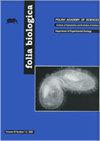哺乳动物细胞铜稳态的分子机制
IF 0.8
4区 生物学
Q4 BIOLOGY
引用次数: 2
摘要
铜(Cu)是所有生物体生长发育所必需的微量元素,是体内仅次于铁和锌的第三丰富的微量金属。铜对维持所有活细胞的生命过程至关重要,因为几种铜依赖性酶在关键的生理过程中发挥着重要作用,如细胞呼吸、氧自由基清除、铁的运输和神经递质合成。维持铜稳态意味着维持全身细胞和液体中铜水平的恒定性,以支持正常生活过程中的酶和其他因素。因此,活生物体已经发展出维持其生理铜水平的复杂机制,因为过量的铜水平可能对细胞有毒。在细胞中,铜稳态由铜结合蛋白和转运蛋白网络控制。此外,铜的摄取是由膜转运蛋白CTR1和CTR2蛋白介导的。在细胞质中,它与一组独特的金属伴侣蛋白(ATOX1,CCS COX17)结合,并转运到不同的细胞区室,在那里它与受体蛋白连接。铜转运ATP酶(ATP7A和ATP7B)负责将铜转移到高尔基体中,在那里铜被添加到酶的活性位点,并且它还被引导到过量细胞铜去除的路径上,以防止毒性的发生。本文章由计算机程序翻译,如有差异,请以英文原文为准。
Molecular Mechanisms of Cellular Copper Homeostasis in Mammals
Copper (Cu) is a trace element necessary for the growth and development of all living organisms, and is the third most abundant trace metal in the body after iron and zinc. Copper is essential for maintaining the life processes in all living cells, because several copper-dependent enzymes
play an important role in key physiological processes like cellular respiration, oxygen radical scavenging, the transport of iron and neurotransmitter synthesis. Maintaining copper homeostasis implies maintaining the constancy of copper levels in the cells and fluids throughout the body, in
order to support the enzymes and other factors that underlie normal life processes. Therefore, living organisms have developed complex mechanisms for maintaining their physiological copper level, because an excess copper level can be toxic for the cells. In the cell, copper homeostasis is
controlled by a network of copper-binding proteins and transporters. Furthermore, copper uptake is mediated by the membrane transporter CTR1 and CTR2 proteins. In the cytoplasm, it is bound to a unique group of metallochaperones (ATOX1, CCS COX17) and transported to different cell compartments,
where it is linked to the recipient proteins. The Cu-transporting ATPases (ATP7A and ATP7B) are responsible for transferring copper into the Golgi apparatus, where the copper is added to the active sites of enzymes, and it is also directed onto the path of excess cellular copper removal to
prevent the occurrence of toxicity.
求助全文
通过发布文献求助,成功后即可免费获取论文全文。
去求助
来源期刊

Folia Biologica-Krakow
医学-生物学
CiteScore
1.10
自引率
14.30%
发文量
15
审稿时长
>12 weeks
期刊介绍:
Folia Biologica (Kraków) is an international online open access journal accepting original scientific articles on various aspects of zoology: phylogeny, genetics, chromosomal studies, ecology, biogeography, experimental zoology and ultrastructural studies. The language of publication is English, articles are assembled in four issues per year.
 求助内容:
求助内容: 应助结果提醒方式:
应助结果提醒方式:


